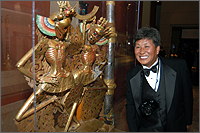| 
Treasures From the Roof of the
World: Professor Helps Museum in Exhibiting Tibetan Treasures
From Dateline (November 20, 2003)
 |
| Nawang Phuntsog, associate
professor in elementary and bilingual education, stands
next to a Tibetan sculpture, “Lords of Dance,”
a symbolic representation of life, death and rebirth.
Phuntsog provided translations for the items on display
at “Treasures from the Roof of the World,”
an exhibit of Tibetan artifacts at the Bowers Museum in
Santa Ana. |
|
 |
Nawang Phuntsog, associate professor in elementary
and bilingual education, was one of more than 120,000 who fled Tibet
after its occupation by Chinese forces in 1959. A toddler at the
time, he had no memory of his country but was instructed in its
language and customs by exiled Tibetans who fashioned a new life
in a small Indian town near the Tibetan border.
Recently, Phuntsog played an importanat role with
the landmark exhibit at the Bowers Museum in Santa Ana. “Treasures
From the Roof of the World,” a collection of nearly 200 priceless
objects from the 1,000-room Potala Palace (built in the 1600s by
the fifth Dalai Lama), features sculptures, paintings, textiles
and ritual Buddhist objects. Phuntsog, who speaks, reads and writes
Tibetan, was instrumental in providing translations that explain
the origins of the various artifacts on display.
“This was an enormous undertaking for the Bowers
Museum and I am very proud to be a part of it,” Phuntsog said.
“Cal State Fullerton has always enjoyed a close relationship
with the Bowers Museum –
specifically the Education Out-reach Program. And so about seven
months ago, I was invited to meet with their administrators and
curators. My job was two-fold: To provide translations for the artifacts
on exhibit, and to help develop a curriculum guide for teachers
who want their students to better understand Tibetan culture and
its history.”
Phuntsog believes the exhibit is important in demonstrating
how rich and sophisticated is Tibetan culture.
“There has been a great deal of propaganda,
particularly by China, to reinforce the position that Tibetans are
ignorant and backward,” he explained. “I don’t
think anyone who sees this exhibit will come away with that perception.
This exhibit showcases Tibet’s fine artistry, as well as the
country’s history and culture. The essence of our culture
is non-violence, compassion, wisdom and respect. All the artifacts
are symbolic of these important messages.”
One artifact in particular, has special meaning for
Phuntsog.
“There is a small statue of King Songsten Gampo
from the 13th century,” he said. “When I had the opportunity
to be in front of this statue, I looked very long and hard into
its eyes. He was one of Tibet’s great leaders who united Tibet
and introduced Buddhism and Tibetan letters of the alphabet during
his rule in the eighth century. He is my cultural icon.”
The reference to “roof of the world”
helps viewers understand the secluded location of the palace high
in the mountains.
When the Tibetans revolted, declaring their independence
in 1959, the Chinese military crushed them. The 14th Dalai Lama,
considered the manifestation of Avalokiteshvara (the Lord of Compassion)
whose role is to rescue others from suffering, fled along with his
people.
Phuntsog finally met the Dalai Lama when His Holiness
made an appearance on campus in 2000. Phuntsog was instrumental
in bringing the Dalai Lama to the university, and he remains interested
in helping others learn more about Tibetan culture. That interest
led to his work with the Bowers exhibit.
“What’s important to keep in mind is
that Tibetan culture is very symbolic in its nature and each piece
in the museum must be understood with its symbolic representation
in order for all to appreciate their true iconic significance. Tibet
is a country where people invested much of their time and energy
in spiritual pursuits to a degree we have not seen elsewhere,”
he said.
Not a surprising admission from a man who has a banner
in his office paying homage to Manjushri – the goddess of
wisdom.
“This is why it’s important to understand
Tibetan symbolism,” Phuntsog explained. “Manjushri holds
both a book – an important symbol of wisdom – and a
sword. The sword represents cutting ignorance but to someone unfamiliar
with the symbolism, it could represent some sort of violence. ”
« back to People
|